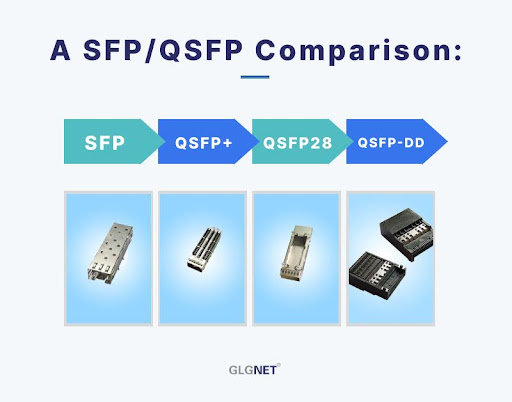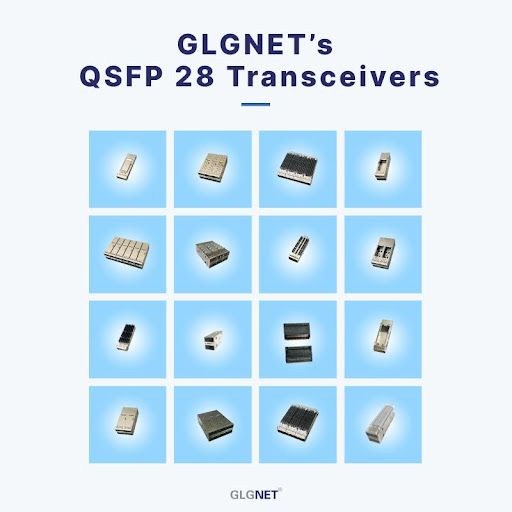There are now many different types of network connectors available on the market, like QSFP, QSFP+, and QSFP 28. We are here to explain their differences. Selecting the right connector will definitely increase your efficiency. Choose the best one for your network connection needs with GLGNET.
SFP+ vs. QSFP+ vs. QSFP28 VS. QSFP-DD: Connector Differences
Let’s discuss your QSFP28 requirements for your applications!
What Is a QSFP Connector?
SFP, which stands for Small Form-factor Pluggable, is a compact, hot-pluggable transceiver used for both telecommunication and data communications applications. It is designed to support data rates ranging from 155 Mbps to 4.25 Gbps. The SFP transceivers are used to connect a network device motherboard (for a switch, router, media converter, or similar device) to a fiber optic or copper networking cable. SFP is utilized for 100BASE or 1000BASE applications compliant with the standards of IEEE802.3 and SFF-8472
QSFP is a hot-pluggable transceiver for data communications with specifications supporting Ethernet, Fibre Channel, and InfiniBand. The “Q” in these terms stands for “Quad”, meaning four channels. It is also available in single-mode and multimode applications. The QSFP module comes in different types: 4x1G QSFP, 4x10G QSFP+, and QSFP 28. These types may share identical small form factors, but they support different data rates and breakout connections.
The key advantage of QSFP over SFP lies in its increased data transmission capabilities and port density. A single QSFP+ connector can replace four standard SFP+ connectors, thus resulting in higher port density, better throughput, and overall system cost savings. Moreover, the quad channels in QSFP connectors allow for more robust and flexible networking designs, such as stackable networking configurations. The expanded data rate is particularly beneficial in meeting the growing bandwidth demands in data centers and large-scale telecommunication networks45.
QSFP vs QSFP+
What is QSFP+? QSFP+ stands for Quad Small Form-factor Pluggable Plus,which is an upgraded version of QSFP designed to accommodate higher data transmission speeds. The QSFP+ speed is characterized by its ability to handle four 10 Gbit/s channels, thereby enabling it to carry 10-Gigabit Ethernet, 10G Fiber Channel, or InfiniBand. This allows for the use of 4x10G cables and enables QSFP+ to break out into 4x10G or 1x40G connections. QSFP+ modules can be applied to connecting switches, Host Bus Adapters (HBAs), data centers, high-performance computing (HPC), and storage systems.
QSFP+ vs QSFP28
What Is QSFP 28?
QSFP 28 stands for Quad Small Form-factor Pluggable 28, which is an upgraded version of QSFP+. The “28” shows that each lane can carry up to 28G data rate. QSFP 28 is designed for 100G applications as SFP28 can do 4x25G breakout connection, 2x50G breakout, or 1x100G depending on the transceiver. Accordingly, it is possible for a QSFP 28 to be connected with a 40G QSFP+ transceiver.
The QSFP 28 comes in many different features. Let’s delve in deeper:
4 Electrical Lanes: With the speed of transmitting data at 28 Gbps, the configuration allows QSFP 28 to achieve a total potential data transfer rate of up to 112 Gbps.
Hot-Swappable Design: Allows replacement without network shutdown, valuable for mission-critical applications.
Advanced IC Technology: Utilizes integrated circuits with digital signal processing, equalization, and clock data recovery for high-speed data transfer.
Digital Signal Processing (DSP): Compensates for signal distortion caused by the transmission medium, enhancing signal-to-noise ratio and ensuring reliable data transmission.
Equalization: Corrects signal distortion from the transmission channel, maintaining signal integrity and reducing errors.
Clock Data Recovery (CDR): Extracts the clock signal accurately from incoming data, enabling synchronization for proper decoding and error correction.
Different QSFP 28 Modules
QSFP 28 modules come in different configurations, each designed to meet specific data transmission requirements. The different types are distinguished by the type of transmission media, transmission rate, transmission distance, and power consumption. Every QSFP 28 module includes one or more QSFP 28 transceivers, ports, and connectors. These components determine the configuration and capabilities of the module. A few common QSFP 28 modules include:
QSFP28 SR4: Designed for short-range transmission but with a low wavelength of 850 nm, this module uses multi-mode fiber (MMF) to support a maximum transmission distance of 100 meters.
QSFP28 LR4: Using duplex single-mode fiber, this module prioritizes long-range transmissions with a maximum transmission distance of 10 kilometers.
QSFP28 PSM4: With parallel single-mode fiber, it uses four pairs of single-mode fibers to transmit data. It operates at a wavelength of 1310 nm.
QSFP28 CWDM4: To operate at 4 different wavelengths, CWDM4 uses a single pair of single-mode fibers to transmit data.
Each of these modules comprises one or more QSFP28 transceivers, ports, and connectors, which collectively determine the module’s configuration and capabilities. The various configurations of the QSFP28 ports in these modules allow for a flexible and robust data communication infrastructure.
QSFP-DD VS. QSFP28
The primary differences between QSFP-DD and QSFP28 are centered around their structure, bandwidth, and backward compatibility. While both have similar dimensions, QSFP-DD is equipped with an 8-lane electrical interface, doubling the ASIC ports to support existing interfaces like CAUI-4. This increases the module's bandwidth capability to 400Gbps, compared to QSFP28's 100Gbps.
Furthermore, QSFP-DD's mechanical interface on the host board is slightly deeper to accommodate the extra row of contacts. This design makes QSFP-DD backward compatible with previous QSFP system transceiver modules, aiding in reducing network upgrade costs while supporting higher bandwidths1.
Why Choose GLGNET’s QSFP Connectors?
GLGNET specializes in the production of high-quality connectors and cages for data communication systems. One of our flagship products is the QSFP transceivers, which are designed to meet the demanding requirements of high-speed data transmission.
What sets GLGNET's QSFP transceivers apart is our professional CAE team and laboratory equipment, which allows for professional SI (signal integrity) performance simulation testing, analysis, debugging, and improvement. This ensures that their products meet the strictest industry standards, including SFF or MSA standards.
We also hold TE and Molex-authorized interface patents for the QSFP transceivers, which is a testament to technical expertise and innovation. Furthermore, we have set up a separate dust-free production workshop for QSFP28 products to ensure optimal product performance.
Our fully automatic production process provides a more competitive price, more stable quality, and shorter delivery time. This is possible due to the advanced manufacturing equipment and strict quality control measures.
Let’s discuss your QSFP28 requirements for your applications!


